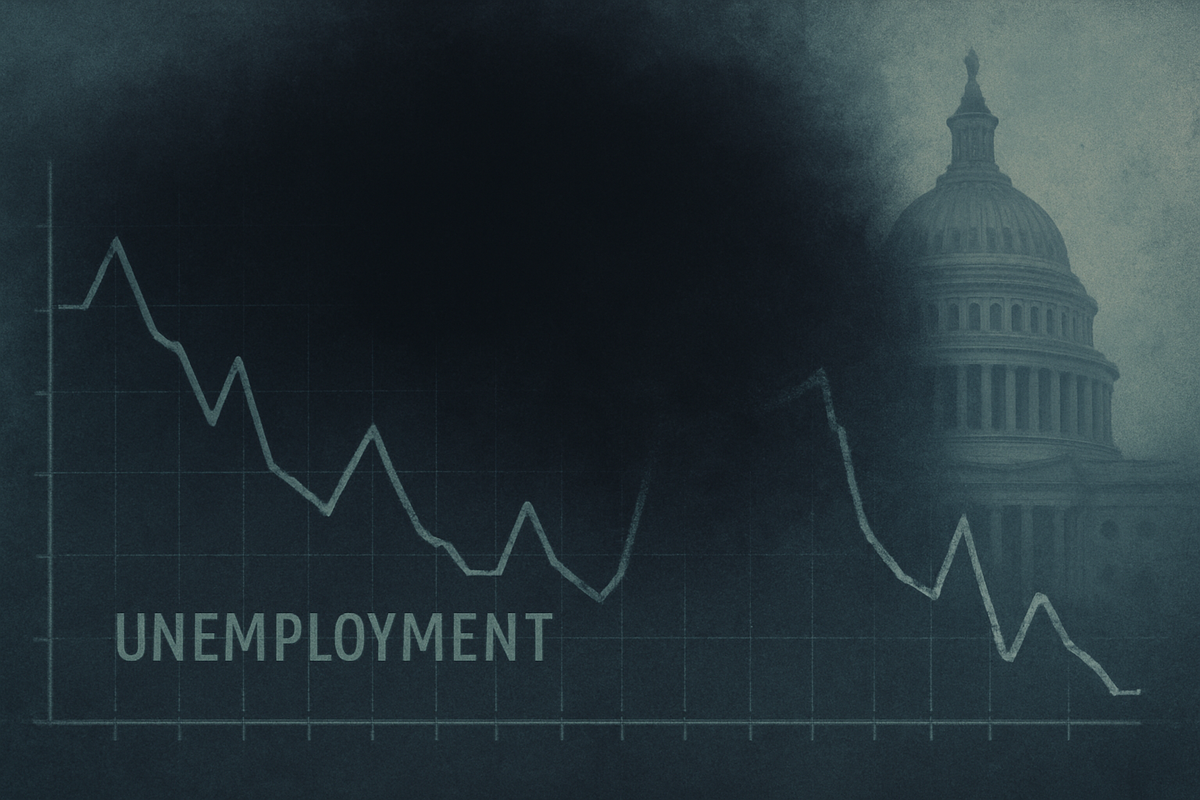
The U.S. economy finds itself navigating treacherous waters as a federal government shutdown, initiated on October 1, 2025, has led to an immediate and critical delay in the release of vital unemployment data. This unprecedented blackout of economic information has plunged the nation's understanding of its labor market into uncertainty, effectively obscuring the true state of employment, wage growth, and labor force participation. As businesses, investors, and policymakers grapple with this data vacuum, the capacity for accurate economic forecasting and strategic planning is severely compromised.
The suspension of operations at key agencies, including the Bureau of Labor Statistics (BLS), means that the highly anticipated monthly jobs report, along with other critical indicators, will not be published as scheduled. This creates a significant void, forcing analysts to rely on incomplete private data and leaving the Federal Reserve and businesses without the comprehensive, reliable statistics needed to make informed decisions in a period already marked by economic concerns. The implications are far-reaching, threatening to exacerbate market volatility and delay crucial policy responses.
The Unfolding Data Blackout: A Closer Look at the Shutdown's Grip
The current federal government shutdown commenced at 12:01 a.m. EDT on October 1, 2025, following a failure in Congress to pass appropriations legislation for the 2026 fiscal year. Now in its second day, the impasse shows no immediate signs of resolution, directly impacting the operations of numerous federal agencies deemed non-essential, including those responsible for collecting and disseminating economic statistics.
Specifically, the Bureau of Labor Statistics (BLS), a cornerstone for labor market insights, has suspended all data collection activities for its surveys, halted website updates, and ceased the publication of its crucial economic reports. This includes the monthly jobs report, which was originally slated for release on October 3, and other key inflation data such as the Consumer Price Index (CPI) and Producer Price Index (PPI), expected around mid-October. The absence of these official statistics leaves a significant gap in the public's and policymakers' understanding of the labor market's health, particularly concerning job growth, unemployment rates, and wage trends, especially amidst growing concerns about a potential economic slowdown.
Key players in this scenario include the U.S. Congress and the White House, whose inability to agree on a budget has triggered the shutdown. Stakeholders across the economy, from the Federal Reserve to individual investors and large corporations, are directly affected. Initial market reactions have been characterized by increased uncertainty and a cautious stance. While some private data sources, such as ADP's employment report, which indicated a loss of 32,000 jobs in September, have emerged, they are not a complete substitute for the comprehensive official government statistics. The prospect of hundreds of thousands of federal workers being furloughed, potentially impacting the unemployment rate, further underscores the gravity of this data blackout.
The timeline of events points to a rapid deterioration from legislative gridlock to economic data paralysis. With the fiscal year beginning on October 1st, the lack of a funding agreement immediately triggered the shutdown. The impact on data release was almost instantaneous, with the BLS confirming the suspension of its activities. This situation echoes previous government shutdowns, where data delays have consistently created a fog of uncertainty, hindering the ability of economic actors to make timely and accurate assessments.
Navigating the Fog: Corporate Winners and Losers in a Data-Scarce Environment
The delay in U.S. unemployment data, stemming from the federal shutdown, creates a challenging environment where some companies may find themselves unexpectedly advantaged, while others face significant headwinds. The primary impact stems from the increased uncertainty, which complicates business planning, investment decisions, and hiring strategies.
Companies with robust internal data analytics capabilities and diversified market intelligence sources may be better positioned to navigate this data vacuum. Large technology firms (NASDAQ: GOOGL), for instance, often possess proprietary data on consumer spending, employment trends within their ecosystems, and broader economic activity. This internal insight could provide a competitive edge, allowing them to make more informed decisions while their rivals struggle with the absence of official statistics. Similarly, financial institutions (NYSE: JPM) with extensive research departments and access to real-time transaction data might also leverage their resources to gain a clearer picture of economic conditions, potentially identifying opportunities or mitigating risks ahead of their less-informed competitors.
Conversely, businesses heavily reliant on official government statistics for their market analysis, strategic planning, or regulatory compliance are likely to suffer. Small and medium-sized enterprises (SMEs), which typically lack the resources for extensive in-house economic research, will find it particularly difficult to assess the health of the labor market, impacting their hiring decisions, expansion plans, and overall risk assessment. Retailers (NYSE: WMT), for example, depend on unemployment figures and consumer confidence data to forecast demand and manage inventory. Without this information, they face increased risks of overstocking or understocking, leading to potential revenue losses or missed sales opportunities.
Furthermore, industries sensitive to economic shifts, such as manufacturing (NYSE: CAT) and construction (NYSE: DHR), which use labor market data to gauge demand for their products and services, will face heightened uncertainty. Companies in the staffing and recruitment sectors (NASDAQ: RHI) are also directly impacted, as their business models are intrinsically linked to the dynamics of the labor market. A lack of clear unemployment data makes it harder for them to predict hiring trends, allocate resources, and advise clients effectively. This situation could lead to a slowdown in hiring activity across various sectors as businesses adopt a wait-and-see approach, further exacerbating the economic uncertainty.
Wider Significance: A Deep Dive into Market and Policy Repercussions
The delay in U.S. unemployment data due to the federal shutdown extends far beyond immediate market reactions, casting a long shadow over broader industry trends, regulatory frameworks, and the very stability of the financial system. This event underscores the critical interdependence of government functions and economic health, revealing potential ripple effects that could reshape market behavior and policy considerations for months to come.
From a broader industry trend perspective, this data blackout accelerates a shift towards private sector data analytics and alternative economic indicators. As official government data becomes unreliable or unavailable, businesses and financial institutions are compelled to invest more heavily in proprietary data sources, artificial intelligence-driven forecasting models, and even satellite imagery or anonymized transaction data to fill the void. This trend could disadvantage smaller firms unable to afford such sophisticated tools, widening the information gap between market leaders and followers. The financial technology (FinTech) sector (NASDAQ: PYPL) might see increased demand for its data-driven insights and analytical services as companies seek to navigate the uncertainty.
The ripple effects on competitors and partners are also significant. Supply chains, already stressed by global events, face renewed pressure as businesses become more cautious about production and investment without clear demand signals from the labor market. Companies reliant on just-in-time inventory systems may struggle to adapt to unpredictable shifts in consumer behavior driven by economic uncertainty. Regulatory bodies, including the Federal Reserve, are directly impacted, as their ability to formulate and implement effective monetary policy is severely hindered. The Fed relies on comprehensive labor market data to assess inflationary pressures and economic growth, and without it, critical decisions on interest rates and quantitative easing become more speculative, potentially leading to policy missteps.
Historically, government shutdowns have consistently demonstrated their capacity to disrupt economic activity and market confidence. The 2013 shutdown, for instance, led to a temporary dip in consumer confidence and a slowdown in government spending, with economists estimating a drag on GDP growth. More recently, the 2018-2019 shutdown also caused delays in economic data releases, contributing to market volatility. Each instance highlights the fragility of economic stability when essential government functions are interrupted. These precedents suggest that the current delay in unemployment data is not merely an inconvenience but a significant impediment to accurate economic assessment and a potential catalyst for prolonged market uncertainty. The situation also raises questions about the resilience of economic institutions in the face of political gridlock, prompting calls for more robust contingency plans to ensure data continuity during future disruptions.
What Comes Next: Navigating the Uncertainty Ahead
The path forward from the current data blackout is fraught with both challenges and potential opportunities, demanding strategic pivots and adaptations from all market participants. In the short term, the immediate priority will be the resolution of the federal shutdown and the subsequent release of the delayed unemployment data. Once the BLS resumes operations, there will likely be a surge of economic reports, creating a concentrated period of data digestion for analysts and investors. This "data dump" could lead to significant market volatility as previously unknown trends are revealed, potentially triggering sharp reactions in equity, bond, and currency markets.
In the long term, the implications are more profound. The repeated vulnerability of critical economic data to political impasses may push for greater diversification in data sources and a re-evaluation of how economic health is measured. This could accelerate the development and adoption of private sector and alternative data metrics, potentially diminishing the singular influence of government reports over time. Companies may invest more in their internal economic intelligence capabilities, fostering a more resilient and distributed understanding of market conditions.
Potential strategic pivots for businesses include a renewed focus on scenario planning and stress testing. Without reliable government data, companies will need to develop more robust models for anticipating various economic outcomes, from rapid recovery to prolonged stagnation. This might involve building more flexible supply chains, diversifying revenue streams, and maintaining healthier cash reserves to weather periods of heightened uncertainty. Market opportunities may emerge for businesses that can provide superior data analytics, risk management tools, or innovative financial products designed to thrive in ambiguous economic environments.
Potential scenarios and outcomes range from a swift resolution and a relatively minor economic blip to a prolonged shutdown that significantly dampens consumer confidence and business investment, potentially tipping a fragile economy into recession. Investors should prepare for increased market choppiness and the possibility of delayed or altered monetary policy decisions from the Federal Reserve, which will be operating with limited visibility into the labor market. The most optimistic scenario involves a quick end to the shutdown, followed by a clear, albeit delayed, picture of the labor market that confirms underlying strength, allowing for a swift return to more informed decision-making.
Comprehensive Wrap-up: Assessing the Market's Trajectory
The delay of U.S. Unemployment Data due to the federal government shutdown represents a significant disruption, underscoring the fragility of economic visibility when government functions are interrupted. The key takeaway is the immediate obfuscation of the labor market's true state, hindering the ability of policymakers, businesses, and investors to make informed decisions. This data blackout not only impacts current assessments but also introduces a layer of uncertainty that could ripple through the economy for months to come.
Moving forward, the market will likely remain in a state of heightened caution until the shutdown is resolved and the delayed data is released. The period immediately following the data release could see significant volatility as the market processes a concentrated influx of information. The lasting impact may include a renewed emphasis on diversifying economic intelligence sources beyond government statistics and a greater appreciation for the stability of public institutions. This event also serves as a stark reminder of the interconnectedness of political stability and economic health.
Investors should closely monitor developments in Washington regarding the federal shutdown, as its duration will directly influence the extent of the economic impact. Additionally, they should pay attention to alternative economic indicators from private sector sources, while understanding their limitations compared to comprehensive government data. Companies with strong balance sheets and diversified business models are likely to weather this period of uncertainty better than those with weaker fundamentals or high dependence on specific market conditions. Finally, watch for any shifts in the Federal Reserve's communication, as their ability to navigate this data void will be crucial for maintaining market stability.
This content is intended for informational purposes only and is not financial advice.






